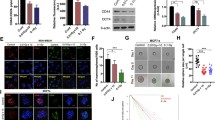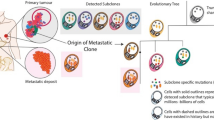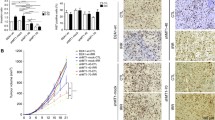Abstract
Background
Metastasis represents the leading cause of breast cancer deaths, necessitating strategies for its treatment. Although radiotherapy is employed for both primary and metastatic breast cancers, the difference in their ionizing radiation response remains incompletely understood. This study is the first to compare the radioresponse of a breast cancer cell line with its metastatic variants and report that such metastatic variants are more radioresistant.
Materials and methods
A luciferase expressing cell line was established from human basal-like breast adenocarcinoma MDA-MB-231 and underwent in vivo selections, whereby a cycle of inoculations into the left cardiac ventricle or the mammary fat pad of athymic nude mice, isolation of metastases to the bone, lung and lymph nodes visualized with bioluminescence imaging, and expansion of obtained cells was repeated twice or three times. The established metastatic cell lines were assessed for cell proliferation, wound healing, invasion, clonogenic survival, and apoptosis.
Results
The established metastatic cell lines possessed an increased proliferative potential in vivo and were more chemotactic, invasive, and resistant to X‑ray-induced clonogenic inactivation and apoptosis in vitro.
Conclusion
Breast cancer metastasis to the bone, lung, and lymph nodes promotes radioresistance.
Zusammenfassung
Hintergrund
Metastasierung ist die Hauptursache für den tödlichen Verlauf von Brustkrebserkrankungen. Darauf müssen spezifische Behandlungsstrategien ausgerichtet werden. Sowohl primäre als auch metastatische Brustkrebsarten können mit einer Strahlentherapie behandelt werden, allerdings sind die Unterschiede in der Reaktion auf ionisierende Strahlung bis heute nicht vollständig verstanden. In dieser Studie wird zum ersten Mal die Strahlenantwort einer Brustkrebszelllinie mit der ihrer metastatischen Varianten verglichen und die erhöhte Strahlenresistenz der metastatischen Varianten gezeigt.
Material und Methoden
Eine Luciferase-exprimierende Zelllinie wurde aus humanen basaloiden Brustadenokarzinomen MDA-MB-231 etabliert und in zwei oder drei Zyklen in vivo selektiert. Dabei wurden die Zellen entweder in den linken Herzventrikel oder in das Fettgewebe der Brust athymischer Nacktmäuse inokuliert. Die durch Biolumineszenz sichtbar gemachten Metastasen wurden aus Knochen, Lunge und Lymphknoten isoliert und expandiert. Die etablierten metastatischen Zelllinien wurden auf Zellproliferation, Wundheilung, Invasion, Klonüberleben und Apoptose getestet.
Ergebnisse
Die etablierten metastatischen Zelllinien wiesen in vivo ein gesteigertes proliferatives Potenzial auf. In vitro zeigten sie erhöhte chemotaktische und invasive Aktivität, zudem besaßen sie eine erhöhte Resistenz gegen röntgenstrahleninduzierte klonogene Inaktivierung und Apoptose.
Schlussfolgerung
Metastasen in Knochen, Lunge und Lymphknoten erhöhen die Strahlenresistenz von Brustkrebs.





Similar content being viewed by others
Abbreviations
- ATCC:
-
American Type Culture Collection
- BW:
-
Body weight
- D 10 :
-
10% Survival dose
- DMF:
-
Dose modifying factor
- ER:
-
Estrogen receptor
- FBS:
-
Fetal bovine serum
- MCF7:
-
Michigan Cancer Foundation-7
- Pg:
-
Progesterone receptor
- SD:
-
Standard deviations
- T D :
-
Doubling time
- TdT:
-
Terminal deoxynucleotidyl transferase
- TUNEL:
-
Terminal deoxynucleotidyl transferase-mediated dUTP-biotin nick-end labeling
References
Blows FM, Driver KE, Schmidt MK et al (2010) Subtyping of breast cancer by immunohistochemistry to investigate a relationship between subtype and short and long term survival: a collaborative analysis of data for 10,159 cases from 12 studies. PLoS Med 7:e1000279
Perou CM, Sorlie T, Eisen MB et al (2000) Molecular portraits of human breast tumours. Nature 406:747–752
Rouzier R, Perou CM, Symmans WF et al (2005) Breast cancer molecular subtypes respond differently to preoperative chemotherapy. Clin Cancer Res 11:5678–5685
van’t Veer LJ, Dai H, van de Vijver MJ et al (2002) Gene expression profiling predicts clinical outcome of breast cancer. Nature 415:530–536
Rodriguez-Pinilla SM, Sarrio D, Honrado E et al (2006) Prognostic significance of basal-like phenotype and fascin expression in node-negative invasive breast carcinomas. Clin Cancer Res 12:1533–1539
Nalwoga H, Arnes JB, Wabinga H, Akslen LA (2010) Expression of aldehyde dehydrogenase 1 (ALDH1) is associated with basal-like markers and features of aggressive tumours in African breast cancer. Br J Cancer 102:369–375
Rantanen V, Grénman S, Kulmala J, Jaakkola M, Lakkala T, Sajantila A et al (1995) Characterization and radiosensitivity of UT-EC-2A and UT-EC-2B, two new highly radiosensitive endometrial cancer cell lines derived from a primary and metastatic tumor of the same patient. Gynecol Oncol 56:53–62
Huerta S, Heinzerling JH, Anguiano-Hernandez YM et al (2007) Modification of gene products involved in resistance to apoptosis in metastatic colon cancer cells: roles of Fas, Apaf-1, NFkappaB, IAPs, Smac/DIABLO, and AIF. J Surg Res 142:184–194
Cai K, Mulatz K, Ard R, Nguyen T, Gee SH (2014) Increased diacylglycerol kinase ζ expression in human metastatic colon cancer cells augments Rho GTPase activity and contributes to enhanced invasion. BMC Cancer 14:208
van den Aardweg GJ, Naus NC, Verhoeven AC, de Klein A, Luyten GP (2002) Cellular radiosensitivity of primary and metastatic human uveal melanoma cell lines. Invest Ophthalmol Vis Sci 43:2561–2565
Feyer PC, Steingraeber M (2012) Radiotherapy of bone metastasis in breast cancer patients – current approaches. Breast Care 7:108–112
Jaboin JJ, Ferraro DJ, DeWees TA et al (2013) Survival following gamma knife radiosurgery for brain metastasis from breast cancer. Radiat Oncol 8:131
Lee SS, Ahn JH, Kim MK et al (2008) Brain metastases in breast cancer: prognostic factors and management. Breast Cancer Res Treat 111:523–530
Steinauer K, Gross MW, Huang DJ, Eppenberger-Castori S, Guth U (2014) Radiotherapy in patients with distant metastatic breast cancer. Radiat Oncol 9:126
Cailleau R, Young R, Olive M, Reeves WJ Jr (1974) Breast tumor cell lines from pleural effusions. J Natl Cancer Inst 53:661–674
Camp JT, Elloumi F, Roman-Perez E et al (2011) Interactions with fibroblasts are distinct in basal-like and luminal breast cancers. Mol. Cancer Res 9:3–13
Brooks SC, Locke ER, Soule HD (1973) Estrogen receptor in a human cell line (MCF-7) from breast carcinoma. J Biol Chem 248:6251–6253
Subik K, Lee JF, Baxter L et al (2010) The expression patterns of ER, PR, HER2, CK5/6, EGFR, Ki-67 and AR by immunohistochemical analysis in breast cancer cell lines. Breast Cancer 4:35–41
Minn AJ, Kang Y, Serganova I et al (2005) Distinct organ-specific metastatic potential of individual breast cancer cells and primary tumors. J Clin Invest 115:44–55
Hackl C, Man S, Francia G, Milsom C, Xu P, Kerbel RS (2013) Metronomic oral topotecan prolongs survival and reduces liver metastasis in improved preclinical orthotopic and adjuvant therapy colon cancer models. Gut 62:259–271
Kang Y, Siegel PM, Shu W et al (2003) A multigenic program mediating breast cancer metastasis to bone. Cancer Cell 3:537–549
Al-Nasiry S, Geusens N, Hanssens M, Luyten C, Pijnenborg R (2007) The use of alamar blue assay for quantitative analysis of viability, migration and invasion of choriocarcinoma cells. Hum Reprod 22:1304–1309
Riou P, Saffroy R, Chenailler C et al (2006) Expression of T‑cadherin in tumor cells influences invasive potential of human hepatocellular carcinoma. FASEB J 20:2291–2301
Hamada N, Hara T, Omura-Minamisawa M et al (2008) The survival of heavy ion-irradiated Bcl-2 overexpressing radioresistant tumor cells and their progeny. Cancer Lett 268:76–81
Hara T, Omura-Minamisawa M, Kang Y, Cheng C, Inoue T (2008) Flavopiridol potentiates the cytotoxic effects of radiation in radioresistant tumor cells in which p53 is mutated or Bcl-2 is overexpressed. Int J Radiat Oncol Biol Phys 71:1485–1495
Hamada N, Ni M, Funayama T, Sakashita T, Kobayashi Y (2008) Temporally distinct response of irradiated normal human fibroblasts and their bystander cells to energetic heavy ions. Mutat Res 639:35–44
Chen J, Gallo KA (2012) MLK3 regulates paxillin phosphorylation in chemokine-mediated breast cancer cell migration and invasion to drive metastasis. Cancer Res 72:4130–4140
Luker KE, Luker GD (2006) Functions of CXCL12 and CXCR4 in breast cancer. Cancer Lett 238:30–41
Banyard J, Chung I, Migliozzi M et al (2014) Identification of genes regulating migration and invasion using a new model of metastatic prostate cancer. BMC Cancer 14:387
Tuxhorn JA, McAlhany SJ, Dang TD, Ayala GE, Rowley DR (2002) Stromal cells promote angiogenesis and growth of human prostate tumors in a differential reactive stroma (DRS) xenograft model. Cancer Res 62:3298–3307
Barone I, Catalano S, Gelsomino L et al (2012) Leptin mediates tumor-stromal interactions that promote the invasive growth of breast cancer cells. Cancer Res 72:1416–1427
Domink F, Carsten B, Gerhard O, Volker D, Naujokat C (2008) Increased expression and altered subunit composition of proteasomes induced by continuous proteasome inhibition establish apoptosis resistance and hyperproliferation of Burkitt lymphoma cells. J Cell Biochem 10:270–283
Acknowledgements
The authors are indebted to Dr. Soile Tapio and Ms. Daniela Hladik (Helmholtz Zentrum München, Munich, Germany) for their help in the German translation of the abstract.
Funding
This work was supported in part by a Grant-in-Aid for Scientific Research C (No. 23591844) from the Ministry of Education, Culture, Sports, Science and Technology (MEXT) of Japan.
Author information
Authors and Affiliations
Corresponding author
Ethics declarations
Conflict of interest
T. Hara, M. Iwadate, K. Tachibana, S. Waguri, S. Takenoshita and N. Hamada declare that they have no competing interests.
Caption Electronic Supplementary Material
66_2017_1165_MOESM1_ESM.pptx
Fig. S1 A flow diagram outlining the isolation of metastases. pGL4.5 cells that stably express luciferase were established from a human basal-like breast cancer cell line MDA-MB-231. pGL4.5 cells were inoculated into the mammary fat pad or the left cardiac ventricle of athymic nude mice. At 20–30 days after inoculation, D‑Luciferin-administered mice underwent bioluminescence imaging. Metastases to the bone, lung and lymph nodes were isolated, and cells were expanded
66_2017_1165_MOESM2_ESM.pptx
Fig. S2 A flow chart schematizing the establishment of metastatic cell lines from pGL4.5 cells by repetitive in vivo selections. pGL4.5 cells underwent injection into the mammary fat pad (MFP) or left ventricular cardiac injection (LVC). Metastases to the bone, lung and lymph nodes were isolated, and cells were expanded. With this first in vivo selection, three, five and four cell lines were obtained from metastases to the lymph nodes, lung and bone (data not shown). Of these, NLN0001, NLU0002 and NBOS0002 cells underwent the second in vivo selection, from which five, three and five cell lines were obtained, respectively (data not shown). From these, NLU0022 and NBOS0022 cells were inoculated into the left cardiac ventricle of five and six mice, respectively, for the third in vivo selection. Cells expanded from isolated lung metastases derived from NLU0022 in five mice were mixed, and named NLU0041 cells. Likewise, cells expanded from isolated bone metastases derived from NBOS0022 in six mice were mixed, and named NBOS0042 cells. For the data in Figs. 1, 2, 3, 4 and 5 and S3, pGL4.5, NLN0001, NLN0104, NLU0041 and NBOS0042 were used (highlighted with boxed characters in the schema)
66_2017_1165_MOESM3_ESM.docx
Fig. S3 Cell proliferation in vitro tested with cell counting and an Alamar Blue assay. a pGL4.5 (circles), NBOS0042 (squares), NLU0041 (diamonds) and NLN0104 (triangles) cells were counted at every 24–196 h after plating. Growth curves were fitted against the data for the cell numbers at 24–120 h after plating to the exponential equation y = a * exp (b * x), where y, x, a and b are the cell numbers, time in h, intercept and slope, respectively. Doubling time (T D) in h was calculated as ln (2 / b). b At every 24–120 h after plating, Alamar Blue was added and fluorescence was measured. For each of the pGL4.5 (black), NBOS0042 (medium grey), NLU0041 (grey) and NLN0104 (light grey) cells, the data for 48–120 h time points are presented as fold changes relative to the data for the 24 h time point, and fold changes represent the means and SD of five independent experiments with triplicate measurements
Rights and permissions
About this article
Cite this article
Hara, T., Iwadate, M., Tachibana, K. et al. Metastasis of breast cancer cells to the bone, lung, and lymph nodes promotes resistance to ionizing radiation. Strahlenther Onkol 193, 848–855 (2017). https://doi.org/10.1007/s00066-017-1165-2
Received:
Accepted:
Published:
Issue Date:
DOI: https://doi.org/10.1007/s00066-017-1165-2




